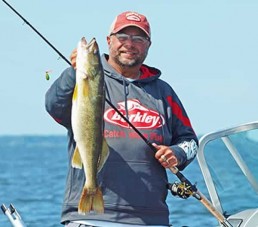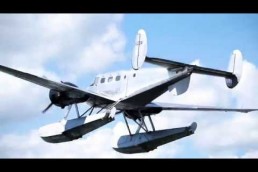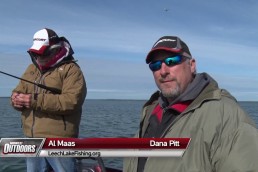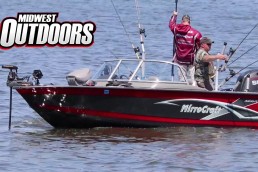Harnessing a Lifetime of Walleye Bites
SHARE THIS POST
What lure catches more walleyes than any other? Bar none, the ‘crawler harness
When I ponder over my fishing career, as well as reminisce about the years of catching fish throughout my childhood, I realize the lure I have used to catch more walleyes than any other during my lifetime is the crawler harness.
A simple rig, to say the least, the ‘crawler harness—also known in the fishing industry as a “spinner”—has the flash and vibration to get noticed from a far; yet, without overdoing it. Spinners have the finesse needed to get even the most fickly fish to bite.
Another reason I use them so much, you ask? Their versatility. By choosing a particular blade, I can either pull them quickly or at a snail’s pace. With the right amount of weight, I can troll them through any section of the water column fish may be.
Oh, and they catch fish, too—lots of fish.
In the beginning
Before choosing the size and shape of a blade, as well the appropriate amount of weight and how much line to let out, I need to know where, exactly, the walleyes are. This is where sonar comes into play.
In my days of youth, my father and grandfather would take me fishing. We didn’t have sonar. Overall, it was more trial and error when we caught fish; as well it was the decades of knowledge of those two dyed-in-the-wool anglers.
To tell you the truth, I feel that had those two been allowed the same data that modern-day sonar and GPS give us today, there wouldn’t be as many fish roaming the waterways we fished within the state of Michigan.
Conversely, at present, if you were to look at both the dash and bow of my Lund Pro-V, you’d see a Lowrance HDS-12 Gen3 Touchscreen Fishfinder/Chartplotter on each. Their large, 12-inch screens allows me to be anywhere in my boat and see the display, even in broad daylight. Within the card readers of those units is a SD card filled with Navionics mapping.
But, it’s not to say you must have these largest of Lowrance units on your vessel. The company makes many models for every walk of life that loves to fish. Every Lowrance sonar/GPS combo, no matter its make, will show you everything you need to know what’s going on under the surface and help you catch more fish. The majority of units will allow you to insert that all-important Navionics card for pin-point accuracy when trolling breaklines and the like.
Seeing is believing
First thing is first, however. I study the screen of my Lowrance before deploying a spinner, watching where the bait is located in the water column, as well as looking for fish.
Because of the way sonar works, I may not always see fish if they are up high in the water column. If I see bait up high—whether it’s pods of shad, shiners or insects—then it is within that same realm where I will place my baits.
In short, if I see forage on my sonar, I am assured there will be fish in the mix at the same depths. On the other hand, if I am marking fish near or on bottom, then that is where I will place my baits.
Once I know where the fish and/or forage is, it’s time to decipher the best blades and weight to use.
High and mighty
First, I’ll start off fishing for walleyes that are high in the water column. Again, I am confident they are here if I am marking forage within the top 15 feet, whether I am seeing fish or not.
Are you enjoying this post?
You can be among the first to get the latest info on where to go, what to use and how to use it!
Take, for example, a trip I took with several colleges to the waters of Green Bay just last year, very near the town of Oconto, Wisconsin. From the port of Ludington, Michigan, we rode upon the passenger ferry S.S. Badger with our vehicles and boats to the port of Manitowoc, Wisconsin, and then drove the short distance north to Oconto.
Once on the water of this large Lake Michigan bay, I saw very few fish near bottom via sonar, yet, lots of bait near the top; thus I let out about 20 to 30 feet of line (10-pound-test Berkley Trilene XT, to be exact), and then clipped on my Church Tackle in-line planer boards and set my rods in my Big Jon rod holders.
Just ahead of the spinners, I used a one-ounce, in-line weight. In general, when trolling at one mph with one-ounce weights, I can estimate my spinner dropping down approximately half the amount of line out behind my Church planer board. For example, with 20 feet of line out, the spinner will run about 10 feet down. If I troll faster, the spinner will rise. If I go slower, it will fall.
Whatever I do, I always make sure my spinners are riding higher than where I think the walleyes are swimming. This is because fish eat forage that is not only swimming at the same depth they are, but will almost always rise up and gobble up food. Rarely will they dive down to eat.
Spin to win
Once I have deciphered the depth the fish are at, it’s then time to choose the proper size and shape of crawler harness blade.
Right off the bat, I will deploy a Northland Pro-Walleye Crawler Harness. Their size-3, deep-cup Colorado blade is the perfect size to start out with. Also, their optically brightened UV blades and Super-Glo beads really stand out, whether fished in clear water or stained. They have a Northland Speed Clevis for a quick change of blades if needed.
The changing of blades is an important thing when trolling. You never know day to day (or hour to hour, for that matter) what size or shape blades will attract the most bites. Different blade types do matter at times.
Colorado blades, for example, spin nicely at medium speed of .08 to 1.5 mph, their design allowing them to give off a lot of “thump” and vibration. Indiana blades, on the other hand, whirl easier than Colorado’s, thus are a great choice for trolling at speeds slower than one mph. Willow-leaf blades, however, work best at speeds greater than 1.5 mph, or, due to their thin shape, will work wonders for getting a crawler to fish in deeper water.
Speaking of crawlers, I always use the freshest, plumpest live night crawlers when pulling spinners. And I keep them cool and lively in a Frabill Crawler Cabin filled with Fat N Sassy Pre-Mixed Worm Bedding. And the crawlers not used up during my fishing trip will stay in great shape for future trips.
Any time small fish such as perch are nipping the tails off my live night crawlers, I’ll switch over to Berkley Gulp! Night Crawlers. These softbaits give off a lot of scent, even more than real crawler after being waterlogged, and there are several different colors to choose from.
Long story short
When it comes to pulling ‘crawler harnesses for walleyes, an entire book could be filled with detailed information. But overall, here’s what you need to remember…
First, find the fish or their forage on your sonar, and then get your crawler harness in the strike zone. Switch out blade sizes and shapes until you find the one that gets bit most. Pay attention to your speed, too. Once both are discovered, stick with it. Use only the liveliest of live bait, or softbaits impregnated with scent.
Do all this and you’ll catch more walleyes on ‘crawler harnesses than ever before.
Mark Martin is a touring walleye tournament angler, as well an instructor with the Ice-Fishing Vacation/School, who lives in the southwest corner of Michigan’s Lower Peninsula. Check out his website at markmartins.net for more information.
MWO
SHARE THIS POST
Did you enjoy this post?
You can be among the first to get the latest info on where to go, what to use and how to use it!
Mark Martin
Mark Martin is a professional walleye tournament angler and instructor with the Ice Fishing School/Vacation series. For more information, check out his website at markmartins.net or fishingvacationschool.com.



